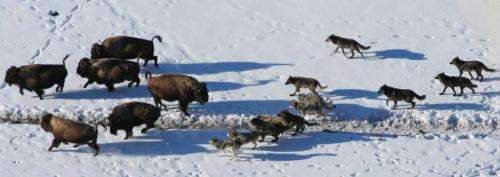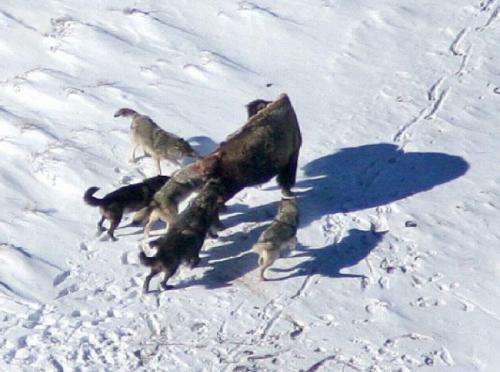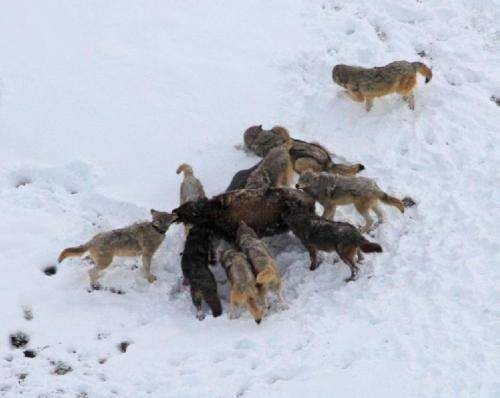The more the merrier: Ecologists say larger group aids wolves' bison hunting

Some 15 years ago, when Utah State University ecologist Daniel MacNulty told his faculty advisor he planned to watch wolves hunt bison in a remote area of Yellowstone National Park, the latter shook his head.
"When I approached him about arranging field research to observe and study this phenomenon, he was skeptical," says MacNulty, assistant professor in USU's Department of Wildland Resources and the USU Ecology Center. "Yellowstone wolves mainly hunt elk, and many thought I was wasting my time trying to observe wolves hunt bison."
Why would wolves hunt the mighty bison, a dangerous, hard-to-kill quarry, when other, easier-to-obtain food was readily available?
Yet, on St. Patrick's Day 1999, during his first trip into Yellowstone's isolated Pelican Valley, MacNulty and colleagues witnessed a group of wolves relentlessly chase and take down a female bison.
"To our knowledge, this was the first recorded observation of wolves successfully hunting an adult bison in Yellowstone National Park," he says.
Since that day, MacNulty has continued field observations of the Yellowstone canines and discovered wolves in large packs are more cooperative when hunting bison than when hunting elk. He and USU doctoral student Aimee Tallian, along with colleagues Daniel Stahler and Douglas Smith of the Yellowstone Wolf Project, report their findings in the Nov. 12, 2014, issue of PLOS ONE. Their research is supported, in part, by the National Science Foundation.
Though many perceive wolves as ferocious and nearly invincible, the predators actually tread a precarious existence.
"Hunting is hazardous business for wolves," says MacNulty, who's witnessed wolves kicked, gored and stomped to death by bison. "Wolves minimize the risk of injury by focusing on vulnerable prey, which are generally rare. So, wolves spend a lot of time on the move searching for the easiest target. Any injury that slows them down may eventually kill them."

A leg fracture, a punctured lung or even a broken jaw or tooth threatens a wolf's survival.
"In addition to hampering travel and nutritional intake, injuries make individual wolves vulnerable to rival packs," he says. "Because of this, wolves are extremely cautious and sensitive to risk."
Therefore, pursuit of a prey as large and formidable as a bison makes little sense unless the hunting group is large enough to level the playing field. A mature bull often weighs a ton.
"In an earlier study, we noted wolves in groups of more than four tend to hold back when pursuing elk," MacNulty says. "Given a choice, wolves will stay out of harm's way until it's safe to enjoy the spoils of the hunt."

But when bison is the prey, as many as nine to 13 wolves will cooperate in the hunt.
"The data we're collecting on wolf hunts is helping us understand how wolf pack size, bison herd size and environmental conditions affect wolves' ability to successfully hunt bison," says Tallian, who was named a NSF Graduate Research Fellow in 2012.
She notes the wolves may have affected the number of bison wintering in fringe habitat in the park.
"We've noticed female bison and their calves no longer winter in Pelican Valley," MacNulty says. "And we're working to determine the extent to which this change is due to wolves."
Observations the researchers have gathered since 1999 offer new insights into wolves' behavior and their pattern of predation, he says.

"This research is especially helpful in Yellowstone, as it's the only national park in the contiguous United States where free-ranging wolves and bison co-exist," says Smith, wildlife biologist and director of the Yellowstone Wolf Project. "Further, the wolf-elk relationship is changing and insight into why wolves sometimes choose bison over elk has great value for understanding ecological dynamics in Yellowstone."
Such findings may assist efforts to prevent conflicts between wolves and livestock.
"Management that takes advantage of wolves' risk-averse behavior may be an effective way to reduce wolf predation on livestock," MacNulty says.
Journal information: PLoS ONE
Provided by Utah State University




















